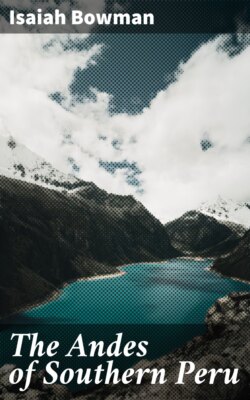Читать книгу The Andes of Southern Peru - Isaiah Bowman - Страница 9
На сайте Литреса книга снята с продажи.
The Highland Shepherd
ОглавлениеThe people who live in the lofty highlands and mountains of Peru have several months of real winter weather despite their tropical latitude. In the midst of a snowstorm in the Maritime Cordillera I met a solitary traveler bound for Cotahuasi on the floor of a deep canyon a day’s journey toward the east. It was noon and we halted our pack trains in the lee of a huge rock shelter to escape the bitter wind that blew down from the snow-clad peaks of Solimana. Men who follow the same trails are fraternal. In a moment we had food from our saddle-bags spread on the snow under the corner of a poncho and had exchanged the best in each other’s collection as naturally as friends exchange greetings. By the time I had told him whence and why in response to his inevitable questions we had finished the food and had gathered a heap of tola bushes for a fire. The arriero (muleteer) brought water from a spring in the hollow below us. Though the snow thickened, the wind fell. We were comfortable, even at 16,000 feet, and called the place “The Salamanca Club.” Then I questioned him, and this is what he said:
“I live in the deep valley of Cotahuasi, but my lands lie chiefly up here on the plateau. My family has held title to this puna ever since the Wars of Liberation, except for a few years after one of our early revolutions. I travel about a great deal looking after my flocks. Only Indians live up here. Away off yonder beyond that dark gorge is a group of their huts, and on the bright days of summer you may see their sheep, llamas, and alpacas up here, for on the floors of the watered valleys that girdle these volcanoes there are more tender grasses than grow on this despoblado. I give them corn and barley from my irrigated fields in the valley; they give me wool and meat. The alpaca wool is most valuable. It is hard to get, for the alpaca requires short grasses and plenty of water, and you see there is only coarse tufted ichu grass about us, and there are no streams. It is all right for llamas, but alpacas require better forage.
“No one can imagine the poverty and ignorance of these mountain shepherds. They are filthier than beasts. I have to watch them constantly or they would sell parts of the flocks, which do not belong to them, or try to exchange the valuable alpaca wool for coca leaves in distant towns. They are frequently drunk.”
“But where do they get the drink?” I asked. “And what do you pay them?”
“Oh, the drink is chiefly imported alcohol, and also chicha made from corn. They insist on having it, and do better when I bring them a little now and then. They get much more from the dealers in the towns. As for pay, I do not pay them anything in money except when they bring meat to the valley. Then I give them a few reales apiece for the sheep and a little more for the llamas. The flocks all belong to me really, but of course the poor Indian must have a little money. Besides, I let him have a part of the yearly increase. It is not much, but he has always lived this way and I suppose that he is contented after a fashion.”
Then he became eager to tell what wealth the mountains contained in soil and climate if only the right grasses were introduced by the government.
“Here, before us, are vast punas almost without habitations. If the officials would bring in hardy Siberian grasses these lava-covered plateaus might be carpeted with pasture. There would be villages here and there. The native Indians easily stand the altitude. This whole Cordillera might have ten times as many people. Why does the government bother about concessions in the rubber forests and roads to the eastern valleys when there are these vast tracts only requiring new seeds to develop into rich pastures? The government could thus greatly increase its revenues because there is a heavy tax on exported wool.”
Thus he talked about the bleak Cordillera until we forgot the pounding of our hearts and our frequent gasps for breath on account of the altitude. His rosy picture of a well-populated highland seemed to bring us down nearer sea level where normal folks lived. To the Indians the altitude is nothing. It has an effect, but it is slight; at any rate they manage to reproduce their kind at elevations that would kill a white mother. If alcohol were abolished and better grasses introduced, these lofty pastures might indeed support a much larger population. The sheep pastures of the world are rapidly disappearing before the march of the farmer. Here, well above the limit of cultivation, is a permanent range, one of the great as well as permanent assets of Peru.
